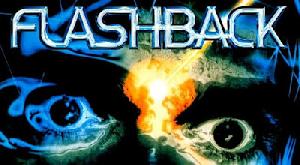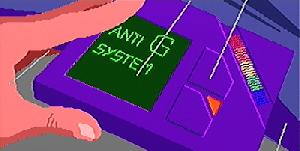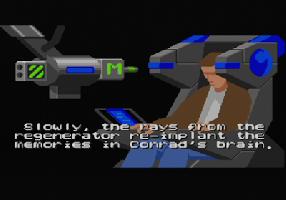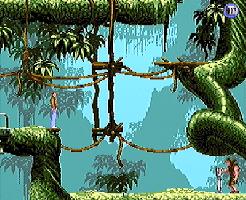
Flashback is one of those games that really doesn't need an introduction, but for the benefit of those who have never played 1992's hottest cinematic platform adventure, I'm prepared to ignore that adage and fill you in on the backstory.
You are Conrad B. Hart, an academic who creates a device to scan the molecular structure of organisms as part of his thesis. Rather than get his thesis published, a slap on the back and a job offer from his educational institution though, Conrad inadvertently discovers a plot by an alien race of shape-shifters who are planning to conquer the Earth. Cue a kidnapping, a brief escape from captivity and a marooning on an alien planet (with a few other familiar tropes such as lost memories and pre-recorded holocubes thrown in for good measure), and you have one rollicking sci-fi adventure on your hands. I won't go into any more detail than that, lest I spoil it for those who have yet to experience Flashback; and for everyone else I'm sure you've already played it multiple times and know all about the rest of the narrative that plays out across the game's various dystopian theatres.

As mentioned earlier, Flashback was initially released back in 1992 for the Amiga, although as documented in an
interview with Retro Gamer
, lead developer Paul Cuisset revealed it was initially programmed for the Mega Drive. The pseudo sequel to 1991's Another World, Flashback went one step further than Delphine Software's previous side-on adventure by introducing some pretty spectacular rotoscoped animation and clever puzzles, as well as some really intense gun play and an interesting plot. When all cut together with some amazing-for-the-time cinematic sequences, Flashback presented gamers with something that was a good few leagues ahead of previous games in the genre, such as the aforementioned Another World and Brøderbund's Prince of Persia.

Since those days of the early 1990s, Flashback has appeared on more systems than you can shake a brown, sticky thing at; and I have personally owned it on Mega Drive, SNES, Jaguar and 3DO. There are also versions for Amiga (as mentioned), PC, CD-i, Mega CD, FM Towns and even the Acorn Archimedes amongst others. It's almost the DOOM of platform games, in that if a system has a screen and a microchip; then it can run Flashback. Happily, that list now also includes the good old Dreamcast, thanks to the hard work of publisher
JoshProd
and seasoned programmer Chui...
|
 |
| The Anti-G belt plays a small but vital part in Flashback
|
While it is true that you have been able to play Flashback on the Dreamcast for some time, the versions available have been less than perfect in execution. You could play it with a Mega Drive or SNES emulator, or even get the Amiga version to run with patience, but all of those options have major drawbacks or caveats, be they control, audio or performance based. This new release of Flashback for Dreamcast comes without any of those annoyances though, and even adds several new features not seen in other ports. Furthermore, as it is built with the original source code and the blessing of Delphine Software's IP holder, it is something of a mash-up of all previous versions which cherry picks the best elements of them to create the definitive Flashback experience. Excited yet? You should be - here's a look at the intro sequence that'll greet you when you fire up the game:
How Does It Play?
From a gameplay perspective, Flashback for Dreamcast remains perfectly faithful. You control Conrad and make him run, roll, leap, hang and shoot as you move from static screen to static screen. I've refrained from using the term 'side scrolling' when describing Flashback because that isn't what it is - you walk, jump or drop off one screen into the next. Sometimes this can lead to leaps of faith or rolls into a group of waiting bad guys, but these situations are few and far between. One of the most startling things about Conrad is the sheer number of different - and often context sensitive - moves he has at his disposal, and just how well animated they are. Again, this is down to rotoscoping (where a real actor's movements are traced), but it works so well in Flashback and really gives the game a distinct identity. As Conrad moves through the game's environments, he will pick up objects that can be used, such as keys for doors and shields that need to be recharged. The stages too are intricately detailed and full of hazards and adversaries; but luckily he isn't defenceless.
|
 |
| We don't condone getting into firefights with cops.
|
|
 |
| Just a standard procedure...
|
Conrad has, from the start of the adventure, a trusty sidearm (with infinite ammo) that can be used to disarm enemy turrets or to simply shoot or pistol whip enemies. It isn't all about gun play though, and don't expect to be finding any other, more spectacular types of weapon throughout the game as the one you start with is the only one you'll ever get to use. However, while fire fights do feature regularly (especially in the later stages) Flashback is more about solving problems and employing muscle memory to best use the acrobatic skills bestowed upon Conrad. Sometimes you'll be tasked with making impossible leaps, other times you'll be racing away from certain death and need to memorise where to roll and where to jump in order to survive. Other times, you'll just be doing menial tasks and fetch quests, talking to NPCs and admiring the scenery. There's something for everyone in Flashback, but make no mistake - the stakes have never been higher, for either the player or mankind in general.
|
 |
| Controls are fully customisable
|
|
 |
| Scaler and filter options are available
|
New Dreamcast Features
But what of this Dreamcast port and the new features you can expect if you decide to splash out? Well happily, they are numerous and really do make it stand out from the rest of the ports on other systems - even the most recent iOS port, in fact. As mentioned, this is a sort of 'best of' amalgamation of the other versions and as such stands apart from the rest. For starters, the extended PC intro is what greets you when firing up the game. There's also a totally new main menu screen, and a host of visual toggles stashed away in the options screen.
|
 |
| No filters
|
|
 |
| With scalers and filters on
|
These allow for the manipulation of screen size, filters and smoothing which are a nice addition, but can actually detract somewhat from the gritty appearance of the original unfiltered graphics. Naturally, these can be disabled if you want to go back to basics, however I'm quite a fan of the smoothed aesthetic and so keep them all dialled up.
|
 |
| The Dreamcast version will also include the PC CD-ROM cut scenes
|
Elsewhere, you can expect to find the full Amiga soundtrack and also full audio voice overs for characters, so you don't have to simply read the conversations onscreen, you can hear them too. The controls are fully customisable to the Dreamcast controller and this only amplifies just how much effort has been put in to making this feel like a bonafide release, and not a simple slap dash, cash grab port.
|
 |
| Don't get lost on the subway - use the map!
|
|
 |
| The original Mega Drive version is included
|
Other new features in this fine Dreamcast re-release include VMU support for on the fly saving (in previous console versions you were limited to level passwords), several new languages, and two 'original' versions of the game. These originals are accessed through a curious option in the main menu titled 'emulation,' and upon selecting this mode you are presented with the choice of starting either the western or Japanese releases of the Mega Drive original. These are fairly similar in truth, with only menu languages setting the two apart (and the screen switches to a more narrow aspect ratio for some reason), but it's a nice extra and allows you to see the original menu screens and visuals. Tapping on the right trigger brings up a familiar 'save anywhere' menu in this emulation mode, and also allows you to seamlessly return to the main menu proper.
|
 |
| Your VMU will make angry eyes at you...
|
I managed to grab a few moments with programmer Chui and he told me the following:
"
The game was initially ported to SDL by the owners and I've worked on that code as a base. It wasn't hard because the game doesn't eat much memory or CPU. There are two kind of graphics filters: the scaler is 2xSai (de-pixellation) and the linear filter. The game was 1:1 screen (256x224) and this is a problem with wide screens. The 2xSai is an original port, and the linear was done by me. Graphics assets are the original MS-DOS
"
Also I've added an interpolation for the sound because it's the 22KHz 8bit Amiga sound assets. At present I'm seeing if I can add Mega CD tracks and the cutscenes as additional bonus content.
"
The game is in English, French, German, Spanish and Italian languages. I've also added and option in the title menu for playing the Mega Drive/Genesis Japan and USA versions with a special Gens4All build. Both (native and emulated) can save the state to vmu and game codes can be shared between versions.
"
- Chui
|
 |
| The cops on Earth can be brutal...
|
|
 |
| Like all bar tenders, this guy is a gold mine of info
|
Summary
In a nutshell, this is the same old Flashback you probably remember, albeit one with a few new bells and whistles. Controls are sharp, visuals are nice (and the added graphics filter options are a cool touch) and the music and sound effects (as brought in from the Amiga version) are absolutely spot on. I did note that on a few occasions the music during cutscenes stopped playing before the cutscene itself had finished and I can only attribute this to some of the longer sequences being used where the music didn't match the length (although I could be wrong, and this
is
a preview build). That said, if you've only ever played the Mega Drive, SNES or Jaguar versions in the past, the addition of character speech is a welcome addition.

Whether you're familiar with Delphine's cinematic masterpiece or a total newcomer to the experience, I can't recommend this new port highly enough. As a standalone title it's hard to beat as an example of a nostalgia-fuelled, 1990s vision of a dystopian future where the odds are stacked squarely against the protagonist. It plays every bit as well as it ever did, and the added extras make this a retro title well worth owning on the Dreamcast.
|
 |
| One of the many impressive cut scenes
|
You can probably already tell, but I'm a huge fan of Flashback and have been since I first played it back in the early 1990s. Not really a fan of the disappointing 2013 reboot, but that's a moot point. The fact is that with all of the positives combined, I'm pretty confident in stating that this could well be the very best version of Flashback we've yet seen - it really is
that
good. It takes all of the best bits from the previous versions and adds so much more, and if the mentioned additional content is added to the final retail release then it's a no brainer for fans of the genre. Even if you own other iterations, you should get this, it's that simple.

Flashback comes in a PAL case with high quality printed inserts and manual (NTSC-U and NTSC-J versions will follow in October 2017), and will be available to pre-order at
Rush On Game
along with the
other new releases from JoshProd
(including 4x4 Jam, Ganryu, Sturmwind and Zia and the Goddesses of Magic) right now. The game is expected to ship in September 2017 and is region free, VGA and VMU compatible.

Yes, we know some people had issues with Rush On Game
last time around
, but please understand we are an independent Dreamcast source - we have no input or control over who sells the games JoshProd publishes. With that in mind, will you be getting Flashback for Dreamcast? Let us know in the comments or join the conversation in our
Facebook group here
!
Update
Flashback from Dreamcast has started shipping (late November 2017) in PAL cases, the NTSC style cases will follow in early December. The game has also been updated slightly with new bonus content -
you can find further details here
.
Related posts: